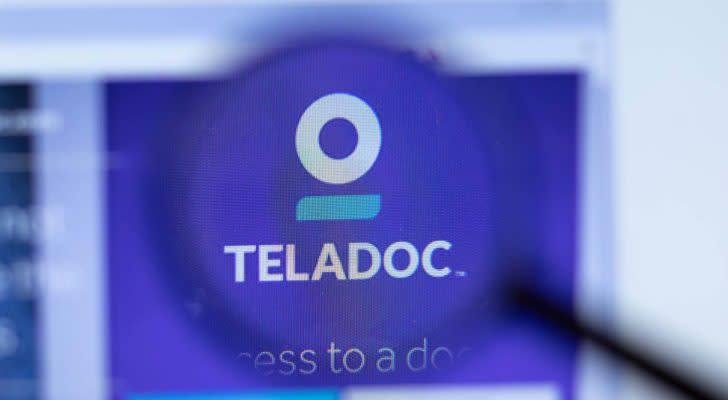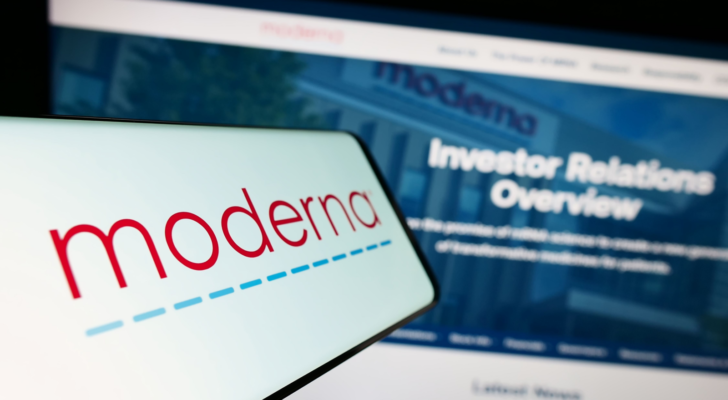7 Healthcare Stocks Taking Medicine to the Next Level
While the technology sector – especially regarding artificial intelligence – may have captured the spotlight, investors ought to consider adding healthcare stocks to their portfolio. If I had to boil it down to one phrase, it would be permanent relevance. A bold claim but I believe there’s much validity to it.
First and foremost, advanced medicine stocks help improve the human condition. Nobody in their last moments wished they had spent more time in the office. Instead, they regret that they didn’t spend enough time with their loved ones. And if we’re being perfectly honest, the innovations undergirding the top biotechnology and pharmaceutical companies help give us more time.
Second, a clear economic directive catalyzes healthcare stocks. According to one assessment, the direct healthcare costs associated with managing illness and disease come out to $4.3 trillion annually. However, we must also consider the indirect expenses – lost labor income, lost productivity to early mortality and the loss to society – that serious conditions impose.
InvestorPlace - Stock Market News, Stock Advice & Trading Tips
I’m not going to say that all medicine stocks exist for the right reasons. Obviously, shady dealings can affect any industry. That said, for investors seeking profits by doing good, these healthcare stocks present compelling arguments.
Boston Scientific (BSX)

Source: Pavel Kapysh / Shutterstock.com
One of the top biomedical companies in the world, Boston Scientific (NYSE:BSX) manufactures medical devices used in interventional medical specialties. Given its tremendous relevance, it’s one of the more consistent healthcare stocks. In the past 52 weeks, BSX gained nearly 28% of equity value. As well, analysts rate shares a consensus strong buy with a max price target of $77.
A major focus area for Boston is interventional radiology. This is a medical specialty that performs various minimally invasive procedures using medical imaging guidance. According to Mordor Intelligence, the global interventional radiology market reached a valuation of approximately $25.46 billion last year. Further, experts project that the segment will expand at a compound annual growth rate (CAGR) of 5.9% to 2028.
At the culmination point, the segment could be worth $33.92 billion. That’s a good reason to put it on your radar of healthcare stocks. Now, BSX isn’t priced at a discount, considering its trailing-year earnings multiple of 72.7X. That said, it has strong operating margins, making it a worthwhile idea.
Globus Medical (GMED)

Source: Dmytro Zinkevych / Shutterstock.com
To be upfront, Globus Medical (NYSE:GMED) currently stands as one of the riskiest healthcare stocks. In the past 52 weeks, GMED gave up almost 24% of equity value. However, it’s been on the move recently, gaining over 17% in the trailing month. So, the specialist in the field of musculoskeletal disorders is worth a look for speculators. Analysts peg shares a moderate buy with a $64.08 average price target.
Fundamentally, Globus will appeal to forward-thinking investors thanks to its revolutionary robotic navigation platform. Through its rigid robotic arm combined with full navigation capabilities, Globus offers a single adaptable platform for accurate alignment in spine surgery. Notably, Strategic Market Research states that the global spinal implants and surgery devices market size reached a valuation of $11.42 billion in 2021. By 2030, the segment could be worth over $18 billion, a CAGR of 5.23%.
When you add in the robotics component, Globus could be an attractive play for the broader field of medicine stocks. Enticingly, GMED trades at a forward earnings multiple of 20X, under the sector median of 24.64X.
iRhythm Technologies (IRTC)

Source: Shutterstock
Another risky but compelling idea for innovative healthcare stocks, iRhythm Technologies (NASDAQ:IRTC) gained 6% of equity value in the past 52 weeks. However, it was a choppy ride to get to that modest performance. Still, recent momentum is encouraging. Also, analysts are looking at the long-term picture, rating IRTC a unanimous strong buy. And that’s among 10 analysts to be clear. The average price target lands at $126.40.
So, why is Wall Street enamored with iRhythm? Likely, it has to do with its wearable, AI-powered electrocardiogram (ECG) system. By providing a continuous heart monitor that can be worn for up to 14 days, iRhythm is redefining the way cardiac arrhythmias are diagnosed. And that’s crucial because the system may help prevent sudden cardiac death.
According to the National Institutes of Health, an estimated 180,000 to 300,000 sudden cardiac deaths (SCD) occur in the U.S. annually. Worldwide, this condition represents the most common cause of death. Therefore, IRTC is easily one of the most relevant healthcare stocks, though investors should be aware of some financial challenges.
Teladoc (TDOC)

Source: Postmodern Studio / Shutterstock.com
A company that needs no introduction thanks to the Covid-19 crisis, telehealth specialist Teladoc (NYSE:TDOC) soared to prominence in 2020. With the mysterious SARS-CoV-2 virus running around, no one wanted to be around strangers. Therefore, the underlying telehealth platform made much sense. However, with the fading of the pandemic, TDOC cratered from its prior highs. In the past 52 weeks, it lost 20% of value.
Still, not all analysts are giving up. True, TDOC is barely hanging onto its moderate buy assessment, which breaks down as six buys and 11 holds. Still, a buy is a buy. Further, it’s not an unreasonable opinion. According to Grand View Research, the global telehealth market size reached a valuation of $101.2 billion last year. Further, the segment may expand at a CAGR of 24.3% to 2030, printing annual revenue of $455.3 billion.
To be fair, the financials present a bit of an issue. For example, investment data aggregator Gurufocus warns that TDOC may be a possible value trap. Nevertheless, if you believe in the narrative – that people are more comfortable in their own homes rather than in a clinical setting – TDOC could be worth a look.
Moderna (MRNA)

Source: T. Schneider / Shutterstock.com
One of the top names under the broader medicine stocks category during the Covid-19 crisis, Moderna (NASDAQ:MRNA) practically became a household name for developing a vaccine for the SARS-Cov-2 virus. Not surprisingly, though, as fears of the pandemic faded, so too did MRNA. In the trailing 52 weeks, the stock lost 43% of equity value, a staggering figure.
Nevertheless, Moderna enjoys support among Wall Street analysts, who rate shares a moderate buy. For full disclosure, it’s a contested assessment, breaking down as eight buys, six holds and two sells. However, the average price target of $129.75 – implying over 21% upside potential – is encouraging. So too is the underlying relevance.
By leveraging its acumen from messenger-RNA-based vaccines, Moderna has partnered with Merck (NYSE:MRK) to develop an experimental mRNA cancer vaccine. According to a Reuters report last month, the vaccine cut the chance of recurrence or death from melanoma by half after three years. That’s a major win, obviously.
While shares represent a big risk given the steep losses, patient speculators may want to look into it. At the least, it has the potential to be a surprisingly robust example of healthcare stocks.
Crispr Therapeutics (CRSP)

Source: rafapress / Shutterstock.com
A compelling and simultaneously controversial idea, Crispr Therapeutics (NASDAQ:CRSP) represents one of the first companies to utilize the CRISPR gene-editing platform to develop medicines for the treatment of various rare and common diseases. As a result, it’s one of the most-talked-about medicine stocks. Sure enough, analysts did it too, pegging it a moderate buy with a $87.26 price target. That comes out to almost 35% upside potential.
But can it get there? Unfortunately, I don’t have a crystal ball. And I don’t like to rely on a company’s own assessments because let’s face it: they’re all going to talk themselves up. However, Precedence Research states that the global gene-editing market reached a valuation of $6.94 billion in 2022. Further, experts believe that the segment could hit $29.93 billion by 2032.
If so, we’re talking about a CAGR of 15.73%. That seems exciting but the problem is that Crispr represents largely a narrative play. For example, its revenue generation is sporadic so it’s difficult to pin down. However, the combination of Crispr’s scientific relevance and projected industry growth makes it one of the compelling healthcare stocks for speculators.
Amylyx Pharmaceuticals (AMLX)

Source: Sisacorn / Shutterstock.com
Several years ago, the ice bucket challenge to raise awareness for amyotrophic lateral sclerosis (ALS) sprouted to much success. It wasn’t just about standing with people who suffer from the disease. Rather, it moved the needle to address it. One of the potential treatments that the ALS Association – which benefitted from the raised funds tied to the ice bucket phenomenon – helped fund was AMX0035.
The company forwarding the therapeutic was Amylyx Pharmaceuticals (NASDAQ:AMLX). What started as an idea in a dorm room at Brown University became one of the top therapeutics to fight ALS. Further, AMX0035 – now known as Relyvrio – received approval from the Food and Drug Administration (FDA) in September 2022. As a result, AMLX holds much promise, earning a unanimous strong buy view among Wall Street analysts.
To be fair, AMLX may be the riskiest idea on this list of advanced healthcare stocks. In the past 52 weeks, it lost more than 56% of equity value. However, if you believe in the underlying science, AMLX may be worth a shot for patient market gamblers.
On the date of publication, Josh Enomoto did not have (either directly or indirectly) any positions in the securities mentioned in this article. The opinions expressed in this article are those of the writer, subject to the InvestorPlace.com Publishing Guidelines.
A former senior business analyst for Sony Electronics, Josh Enomoto has helped broker major contracts with Fortune Global 500 companies. Over the past several years, he has delivered unique, critical insights for the investment markets, as well as various other industries including legal, construction management, and healthcare. Tweet him at @EnomotoMedia.
More From InvestorPlace
The #1 AI Investment Might Be This Company You’ve Never Heard Of
Musk’s “Project Omega” May Be Set to Mint New Millionaires. Here’s How to Get In.
The post 7 Healthcare Stocks Taking Medicine to the Next Level appeared first on InvestorPlace.
